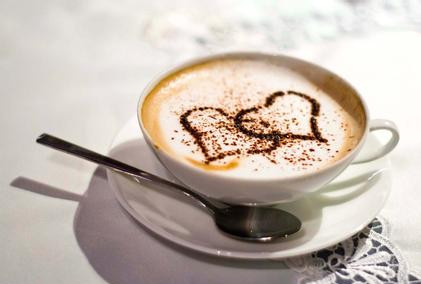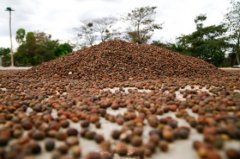The origin of cappuccino is also related to the name of a monkey.

The monks of the St. Franciscan Church (Capuchin), founded after 1525, all wore brown robes and pointed hats. When the St. Franciscan Church spread to Italy, the locals thought that the monks' clothes were very special, so they gave them the name Cappuccino. The Italian word refers to the loose robes and small pointed hats worn by monks, derived from the Italian word "headscarf" or Cappuccio.
However, Lao Yi loved coffee and found that when espresso, milk and milk foam were mixed, the color was like the dark brown robe worn by monks, so he came up with a drink with coffee and sharp milk bubbles, which was named Cappuccino. The word was first used in English in 1948, when a report in San Francisco first introduced cappuccino beverages, and it was not until 1990 that it became a familiar coffee drink. It should be possible to say that the word Cappuccino coffee comes from the St. Franciscan Church (Capuchin) and the Italian headscarf (Cappucio). It is believed that the original word makers of Cappuccino never dreamed that the monks' robes would eventually become the name of a coffee drink.
Cappuccino is also related to the name of a monkey.
It's not over yet. There is a small monkey in Africa with a black cone-shaped hair on its head, much like a pointed hat on a St. Franciscan robe, hence the name Capuchin, which was first used by the British in 1785. Hundreds of years later, the word Capuchin. The generation of coffee drink names and monkey names have always been interesting anecdotes of literati.
Dry cappuccino and wet cappuccino
Did you know that cappuccinos can be dry or wet? The so-called dry Dry Cappuccino refers to the conditioning method with more milk bubbles and less milk. it tastes stronger than milk and is suitable for people with heavy taste. When it comes to wet cappuccino (Wet Cappuccino), it refers to the practice of fewer milk bubbles and more milk, with milk fragrance overshadowing the thick coffee flavor, which is suitable for those with light taste. The flavor of the wet cappuccino is similar to that of the popular latte. Generally speaking, the taste of cappuccino is heavier than latte. If you have a heavy taste, you might as well order cappuccino or dry cappuccino. If you are not used to the heavy smell of coffee, you can order latte or wet cappuccino.
Cappuccino is filled with steamed milk on an extra-strong Italian coffee. At this time, the color of coffee is like a cappuccino monk covering a dark brown coat with a headscarf, hence the name caffeine.
The full-bodied taste of espresso, accompanied by lubricated foam; it has some flavor of "collecting essence and dew". Sprinkled with foamed milk with cinnamon powder and mixed with the aroma of bottom-up Italian coffee, a new generation of coffee makers are constantly acting on it.
Production of cappuccino coffee:
On the basis of Italian espresso, add a thick layer of foaming milk to become a cappuccino. The quality of espresso can be seen in milk and foam, but it is still an important factor in determining the taste of cappuccino. Pour the partially skimmed milk into a pot, then use a foamer to foam and inflate the milk, and let the milk be as uniform as whipped cream without burning. The cappuccino coffee cup should be warm or the milk foam will spread. You can usually put these cups on the top of the coffee maker to keep warm. Pour the milk and foam on top of the espresso and naturally form a layer, just like wrapping the coffee below. Note that the brewed Italian coffee is about five cents full, and the hot milk that has been foamed is about eight cents full. Finally, you can sprinkle a little cinnamon or chocolate powder and pour the rest of the milk together to make a delicious cappuccino.
The traditional cappuccino is 1/3 espresso, 1/3 steamed milk and 1/3 foamed milk. Cappuccino? Latte is actually a change in Italian coffee (Italians are indeed fickle), except that the proportion of coffee, milk and milk foam can be slightly changed to 1:2:1.
Important Notice :
前街咖啡 FrontStreet Coffee has moved to new addredd:
FrontStreet Coffee Address: 315,Donghua East Road,GuangZhou
Tel:020 38364473
- Prev

History of coffee shops History of coffee drinking culture
At the beginning of the seventeenth century Constantinople was the capital of the most powerful empire in Europe. Coffee houses were already very popular in the Ottoman Empire when the British noticed them. The construction of a palatial café became the first act of Ottoman rulers after conquering a city to demonstrate the civilized nature of their rule. Some British travelers and merchants believed that Iraq
- Next

The language of Coffee General knowledge of fine coffee
If you do not want to drink coffee as a sitting thing, from sour, sweet, bitter to experience some profound philosophy of life, just want to simply drink a cup of delicious coffee, then, open the menu of the cafe, in addition to the above pure coffee, you can also try the taste of coffee after shaking hands with wine, milk and chocolate. Milk coffee: milk flavor
Related
- How did the Salvadoran coffee industry develop in Central America?
- What exactly does the golden cup extraction of coffee mean?
- The Origin of Coffee flower
- [2023 Starbucks World Earth Day] there are more meaningful things besides free Starbucks coffee!
- What kind of coffee is there in Spain? 9 Flavors of Spanish Coffee
- Aromatic African coffee| Kenya's coffee culture and historical production area
- Liberica Coffee Bean knowledge: the characteristics of Liberian Coffee beans of the three original species of Coffee beans
- The origin and formula of Spanish latte introduces the taste characteristics of Bombon coffee in Valencia, Spain.
- How to adjust the solution of over-extracted coffee
- What is the tasting period of coffee beans? What is the period of coffee and beans? How should coffee wake up and raise beans?

